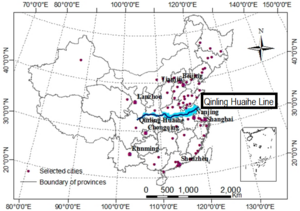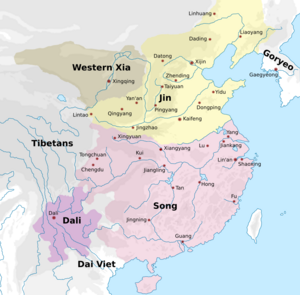Earth:Qinling Huaihe Line
The Qinling Huaihe line (Chinese: 秦岭淮河线; pinyin: Qínlǐng huáihé xiàn) is a reference line used by geographers to distinguish between Northern and Southern China, corresponding roughly to the 33rd parallel.[1][2] Qinling refers to the Qinling Mountains, and Huaihe refers to the Huai River.[3] It divides China into two regions that differ from each other in climate, culture, lifestyle and cuisine. Regions north of the line tend to be temperate or frigid, with snow being a regular feature in winter. Regions south of the line tend to be subtropical and tropical. The south is hotter and wetter than the north.
Historically, the North was more developed (employing the latest technology of that time) than the South. But much has changed in recent times, and half of the most developed Tier 1 cities of China are in the South. It was also in the Ming dynasty that the economy of the South outpaced that of the North.[1][4]
Nowadays, most people acknowledge that divisions within Chinese society do not fall neatly into "north and south" divisions, because of the significant overlap in many regions of China.
History and use
Qinling Huaihe line was first drawn by Chinese geographer Zhang Xiangwen in 1908, defining north China as anything above a line running along the Qinling Mountains in the west and the Huai River the east.[5]
In the 1950s, Premier Zhou Enlai used the line to create a subsidized district heating system only in the colder north, a system still in effect today.[6][7] This has also led to the north to suffer from heavy air pollution due to coal heating plants, but the south to suffer from lack of heating during the winter months.[8]
The line also represents the 800mm annual precipitation line of China.[9]
See also
- Heihe–Tengchong Line
References
- ↑ 1.0 1.1 Shuangshuang, LI; Saini, YANG; Xianfeng, LIU (10 September 2015). "Spatiotemporal variability of extreme precipitation in north and south of the Qinling-Huaihe region and influencing factors during 1960-2013". The Chinese journal of geography 34 (3): 354–363. http://www.progressingeography.com/article/2015/1007-6301/36314. Retrieved 25 May 2017.
- ↑ Kemp, John (2014-05-22). "For ‘dirty man of Asia,’ Russian gas deal offers clean solution" (in en-US). The Japan Times Online. ISSN 0447-5763. https://www.japantimes.co.jp/news/2014/05/22/asia-pacific/social-issues-asia-pacific/dirty-man-asia-russian-gas-deal-offers-clean-solution/.
- ↑ Xingzhong, Liu. "Fungal diversity in China". State Key Laboratory of Mycology. http://www.mycolab.org.cn/templates/T_second_EN/index.aspx?nodeid=452. Retrieved 25 May 2017.
- ↑ "Living Below China’s Qinling-Huaihe Line Leaves Many Southerners in the Cold". Hong Kong University. http://journalism.hkbu.edu.hk/feed/?p=779. Retrieved 25 May 2017.
- ↑ "China's unlikely divide over home heat" (in en). The National. https://www.thenational.ae/uae/china-s-unlikely-divide-over-home-heat-1.270578.
- ↑ Feng, Hao (2017-12-14). "Three-year cut to life expectancy from coal heating" (in en). Eco-Business. http://www.eco-business.com/news/three-year-cut-to-life-expectancy-from-coal-heating/.
- ↑ hermesauto (2018-01-04). "Old central heating rule leaves old Shanghai neighbourhood shivering in winter" (in en). The Straits Times. http://www.straitstimes.com/asia/east-asia/old-central-heating-rule-leaves-old-shanghai-neighbourhood-shivering-in-winter.
- ↑ Huang, Zheping. "Northern China’s dilemma—if you want heat in the winter, it comes with toxic air pollution — Quartz" (in en-US). https://qz.com/544419/northern-chinas-dilemma-if-you-want-heat-in-the-winter-it-comes-with-toxic-fumes/.
- ↑ S.S., Li; J.P., Yan; J, Wan (1 June 2012). "The characteristics of temperature change in Qinling Mountains". Scientia Geographica Sincia 32 (7): 853–858.



